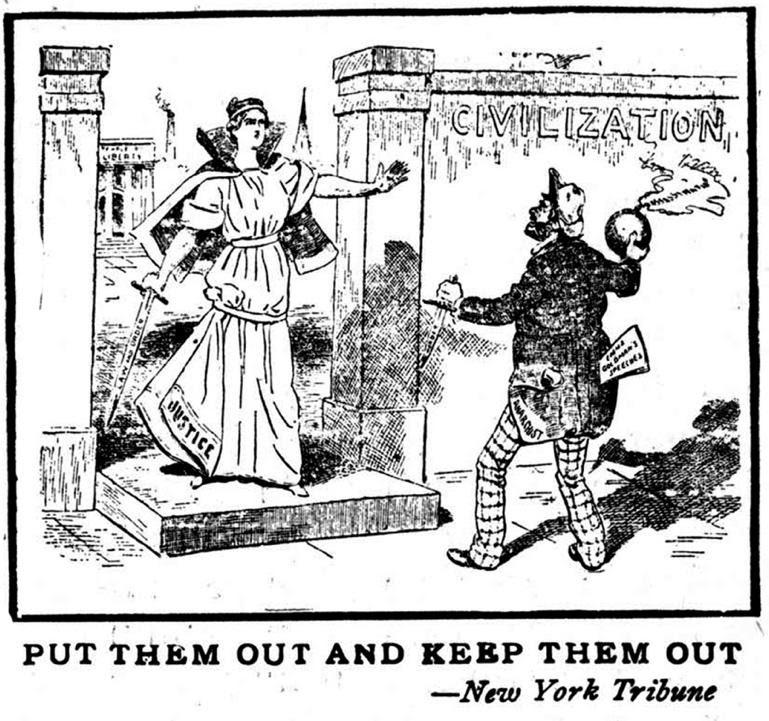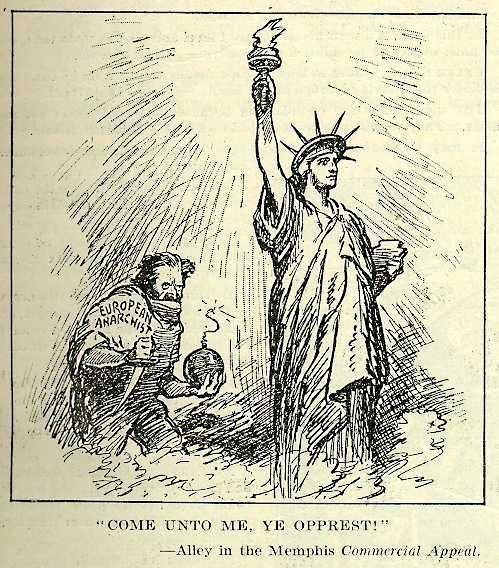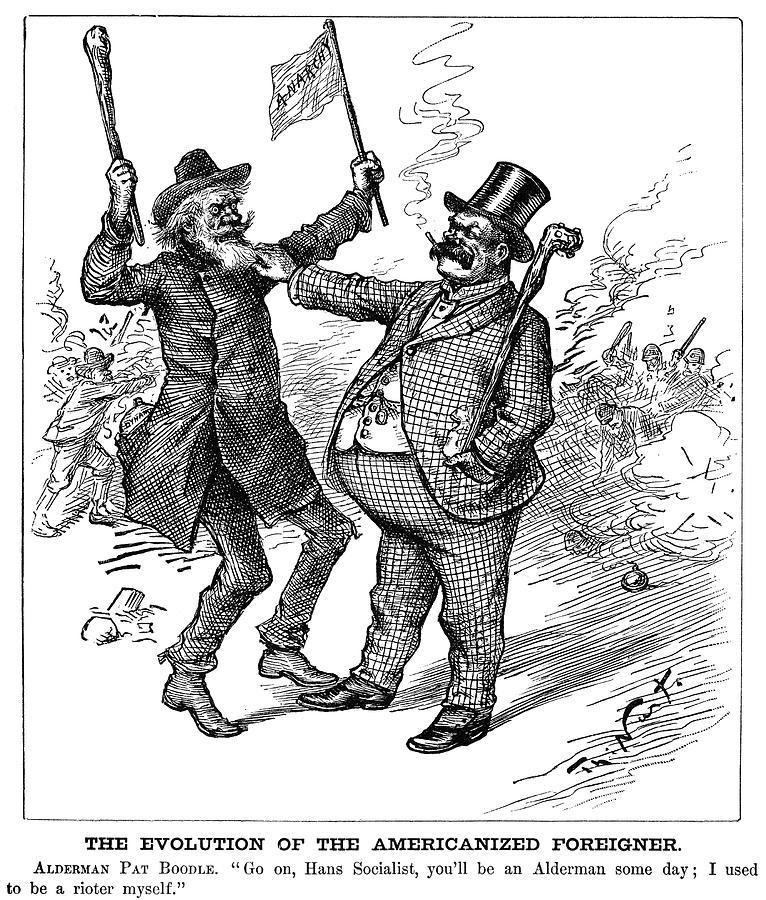Eric Fleischmann
Biden and the Demonization of Anarchism
August 25th, 2020
This year, in response to nationwide protests against police brutality, President Donald Trump has repeatedly attempted to associate Black Lives Matter with anarchists and anarchism. He has tweeted such threatening posts as just the phrase “Anarchists, we see you!” with a video of a man dressed in black at one protest, and he has referred to protesters in Portland, Oregon as “anarchists who hate our Country” and called for Governor Kate Brown to “clear out, and in some cases arrest, the Anarchists & Agitators in Portland.” It is certainly true that many anarchists—such as myself—have been involved in Black Lives Matter protests, but it is obvious that President Trump is not making an objective ideological observation but rather is attempting to use anarchist as a ‘dirty word’ intended to make protestors out to be terroristic criminals.
This is unsurprising coming from a right-wing, authoritarian, corporate capitalist (one might even succinctly say ‘fascist’) who obviously sees anarchism as the antithesis of his vision of the world, but this rhetoric is not confined to Trump and Trumpist Republicans. Recently, in a speech delivered in Wilmington, Delaware, Democratic presidential candidate Joe Biden employed a similar tactic in the following statement: “I’ve said from the outset of the recent protests that there’s no place for violence or destruction of property. Peaceful protesters should be protected, and arsonists and anarchists should be prosecuted, and local law enforcement can do that.” Foregoing discussions around the conflation of violence with property damage, the truly disturbing element of this statement is the association of arson with anarchism and consequently the latter with violent criminality. As MSNBC’s Chris Hayes tweets, “‘anarchist’ is not some free-floating category of criminal. It’s perfectly legal to be an anarchist, as protected by the first amendment and it’s a gross violation of the spirit of liberty to imply otherwise.” And even a 2010 piece on the FBI website about terroristic violence motivated by “anarchist extremism” prefaces its content with the statement that “[a]narchism is a belief that society should have no government, laws, police, or any other authority. Having that belief is perfectly legal, and the majority of anarchists in the U.S. advocate change through non-violent, non-criminal means.”
But both the public demonization and literal criminalization of anarchism—and far-left ideologies in general—is nothing new in American history. Consider the famous examples of both Red Scares in which the U.S. Government and American society at large instigated witch hunts against individuals and groups with leftist sympathies. The first of these (as well as its prelude), occurring in the early 20th century, certainly had strong elements of anti-communism—the 1917 Russian Revolution birthed conspiratorial fears of Bolshevik influence in the United States—but it had a particular emphasis on rooting out anarchism. This can be traced in no small part to the 1886 Haymarket Riot— a landmark event in labor history which culminated in the throwing of a bomb at Chicago police officers for which four anarchists were tried and hanged. And there was also of course the assassination of President William McKinley in 1901 by Polish-American self-proclaimed anarchist Leon Czolgosz and about two decades later the infamous case of Italian anarchists Nicola Sacco and Bartolomeo Vanzetti, who were executed for alleged murder and armed robbery. But as HISTORY explains, “Czolgosz was only nominally connected to the American anarchist movement—certain groups had even suspected him of being a police spy” and “the trial of Sacco and Vanzetti was regarded by many as unlawfully sensational. Authorities had failed to come up with any evidence of the stolen money, and much of the other evidence against them was later discredited.”
But these facts did little to dissuade draconian action against political dissent, such as state legislation in Kansas which made “it felony to display any flag, standard, or banner, of any color or design that is now or may hereafter be designated as the flag, standard, or banner of Bolshevism, anarchy, or radical socialism” and that in Massachusetts which decreed that “[n]o red or black flag, and no banner, ensign, or sign, having upon it any inscription opposed to organized government, or which is sacrilegious, or which may be derogatory to public morals” may be displayed at parades. On a federal level there was the Immigration Act of 1903 (also known as the Anarchist Exclusion Act) which allowed the U.S. government to exclude and deport immigrants associated with anarchism and radical labor movements. And furthermore, there was the Espionage Act of 1917 which, in one section, criminalized dissent (at the time) against American involvement in WW1. Famed anarchist Emma Goldman and IWW icon Eugene Debs were charged under this law, and this same legislation was used much more recently against such figures as Julian Assange and Edward Snowden. And this by no means exhausts the litany of legislation in that era targeted against anarchists (and leftists in general).
Furthermore, public opinions regarding anarchism in the early 20th century can be excellently illustrated in the cartoons of the time, which generally depict a devious-looking, often-foreign man labeled ‘anarchist’ or ‘anarchism’ with a bomb, knife, or another weapon about to strike at symbols of America or liberty or even civilization wholesale:



Thus, Joe Biden’s statements regarding “arsonists and anarchists” and the call for the criminalization of anarchism are neither random nor new, but rather emergent from a historical bias against anarchist thought from late 19th and early 20th century America. As Colin Ward writes in Anarchism: A Very Short Introduction, this era has left, “the cartoonist’s stereotype of the anarchist as the cloaked and bearded carrier of a spherical bomb with a smoking fuse, and this has consequently provided yet another obstacle to the serious discussion of anarchist approaches. Meanwhile, modern political terrorism on an indiscriminate scale is the monopoly of governments and is directed at civilian populations, or is the weapon we all associate with religious or nationalist separatism, both of them very far from the aspirations of anarchists.”
This is not to say that anarchists have never committed acts of violence. Ward openly admits that the aforementioned anarchist stereotype emerged in part because “a century ago . . . a small minority of anarchists, like the subsequent minorities of a dozen other political movements, believed that the assassination of monarchs, princes, and presidents would hasten popular revolution.” And the first Red Scare came into full swing in part because of the series of both attempted and successful bombings from April through June in 1919 carried out by followers of the Italian anarchist Luigi Galleani. And there were anarchists of that era and in the modern day who embrace forms of “illegalism,” which Paul Z. Simons defines as “[t]he open embrace of criminality as an expression of anarchism, particularly individualist anarchism.” This often takes the form of non-violent crime such as shoplifting, counterfeiting, and the sale of illegal substances, but it has historically also taken on violent forms such as with the Bonnot Gang who committed multiple armed robberies and murders in France and Belgium in the early 20th century. But in the late 20th century and early 21st century it is difficult to find substantial anarchist movements that are committed to genuine acts of non-defensive violence. Exceptions might include fringe groups like the Greek anarchists Nihilist Faction, who committed multiple arsons and firebombings in the 90s and early 2000s such as the 1996 bombing of the IBM building in Athens. But even this attack apparently resulted in no deaths and no injuries. And furthermore, there are very few political ideologies that do not at least have some association—historical or otherwise—with violence. A prime example would be the very ideology that Biden himself represents: conventional liberalism (as opposed to its more radical variations).
Academic Internet personality Oliver Thorn explains how liberalism presents itself as both non-violent (and even non-ideological) when in reality basically any political ideology must determine “who are the acceptable targets of violence,” and liberalism is just the same and furthermore defines itself by making exceptions to its publicly stated ideological principles. For example, despite their apparent love for freedom, the acceptable targets according to early liberal thinkers like John Stuart Mill and John Locke were “barbarians” and “savage races” to whom the civil liberties granted to white Europeans were not extended, and despite the liberal Founding Fathers of the United States preaching “Life, Liberty and the pursuit of Happiness” and that “all men are created equal,” most of them owned Black slaves and denied many rights to women. This hypocrisy continues in the present day with most ‘liberal’ countries denying and detaining immigrants deemed ‘illegal’ despite the outward preaching in favor of the freedom of both individuals and goods to move between countries. Thus, liberalism makes exceptions to its theoretical principles in practice in order to perpetuate violence towards ‘others.’ Liberalism also suffers from what is often referred to as the “paradox of sovereignty.” In his book The Democracy Project, David Graeber explains it like this:
the police can use violence to, say, expel citizens from a public park because they are enforcing duly constituted laws. Laws gain their legitimacy from the Constitution. The Constitution gains its legitimacy from something called the “people.” But how did “the people” actually grant this legitimacy to the Constitution? As the American and French revolutions make clear: basically, through acts of illegal violence. (Washington and Jefferson after all were clearly guilty of treason under the laws which they grew up.) So what gives the police the right to use force to suppress the very thing—a popular uprising—that granted them their right to use force to begin with?
So, despite his condemnation of violent ideological criminality, Biden’s power and authority (as senator, vice-president, or potential president) are themselves originally derived from violent criminality—just very old violent criminality. And being any kind of statist ideology, liberalism demands a concentration of violence in the form of the state, which is famously understood by Max Weber in his essay Politics as Vocation as that body which holds the exclusive right to authorize, threaten, and use (particularly physical) violence against people within a given territory.
But even beyond the more historical or ‘abstract’ elements of violence in liberalism, Biden himself has been complicit in violence through the mechanisms of the state. Despite his recent claims to the contrary, Biden was a firm supporter of the Iraq War at its start and throughout its execution—a war that reportedly cost between 185,231 and 208,214 civilian casualties from violence and 288,000 casualties including combatants. And domestically, Biden’s tough-on-crime policies and advocacy for the war on drugs have led to immense violence, theft, and loss (both human and financial) in the United States. As Brittany Hunter writes in an article for the Foundation for Economic Education,
[m]ass incarceration and mandatory minimum sentencing laws have destroyed innocent lives, torn apart families, and cost the American taxpayers $182 billion annually. The practice of civil asset forfeiture has allowed law enforcement to seize money and property from people who were neither charged with nor convicted of a crime. As a young US senator, Biden played a role in the creation and adoption of each of these policies.
So, once again, despite calling for the prosecution of anarchists as violent criminals, Biden himself has propagated—from a safe distance of course—immense destruction, it’s just that his is within the confines of the law. This harkens to Ward’s earlier point that it is not anarchists who are responsible for large-scale violence in the contemporary world but governments, or as Chris Matthew Sciabarra puts it: “It is quite ironic that skeptics will see anarchism as a ridiculous, idealistic, floating abstraction without realizing that the present-day situation is in essence, one of international anarchy among monopoly governments, which have considerably refined the practice of bomb-throwing beyond what any anarchist would have dreamed.”
But the purpose of outlining the violence of liberalism here is not to attempt to justify any non-defensive violence committed by anarchists but rather to further contrast anarchism with most other ideologies in its strong repudiation of violence. In an article for right-wing news site Daily Wire, Emily Zanotti reports that the Portland, Oregon branch of Democratic Socialists of America issued a statement saying in one part that: “We condemn this statement from Joe Biden in which he criminalizes a political ideology that is based on cooperation and mutual care.” And that is an immensely important point: anarchism is a school (or rather schools) of thought based on working together as individuals and communities in the spirit of mutuality and care. Graeber and Noam Chomsky—perhaps the two most famous anarchist thinkers alive today—both present quick definitions of anarchism. Graeber, in his aforementioned book, writes that “[t]he easiest way to explain anarchism . . . is to say that it is a political movement that aims to bring about a genuinely free society—and that defines a ‘free society’ as one where humans only enter those kinds of relations with one another that would not have to be enforced by the constant threat of violence.” And Chomsky says, in an interview with Harry Kreisler, that…
[t]he core of the anarchist tradition, as I understand it, is that power is always illegitimate, unless it proves itself to be legitimate. So the burden of proof is always on those who claim that some authoritarian hierarchic relation is legitimate. If they can’t prove it, then it should be dismantled.
Both these definitions outline how anarchism should not be seen as the ideology of arsonists and looters who have no regard for safety and people’s lives and livelihoods, but rather one based on a fundamental opposition to the violence and domination that pervades present society.
And if the reader takes nothing else away from this article, at least take this: you are far, far, FAR more likely to find a self-described anarchist at your city’s local chapter of Food Not Bombs, working at your town’s food banks and soup kitchens, organizing unions at crony corporations in your county, or organizing any number of ventures to improve your community than you are to find them out in the streets with a cartoon-ish bomb (or a very real Molotov cocktail) committing acts of violence against innocent people.